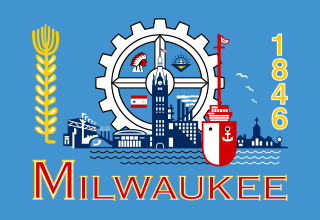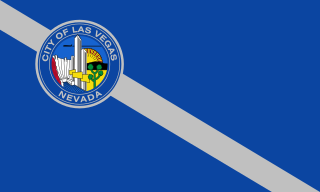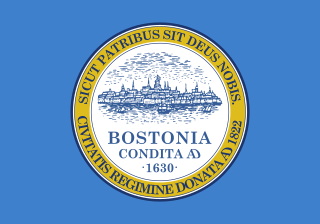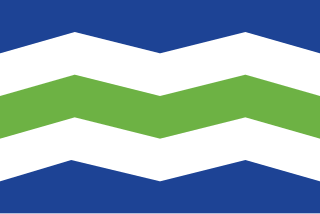The flag of Minneapolis is the official municipal flag of Minneapolis, Minnesota.
The flag of Minneapolis is the official municipal flag of Minneapolis, Minnesota.
On May 27, 1955, Minneapolis City Council unanimously adopted a new design for its flag. The flag and its symbols were described in the resolution as such: [1]
A royal blue pennant on a white field or background with a white circle on a blue pennant divided by four parts; each of the four parts of the circle containing a blue symbol, i.e., a building symbolizing education and the arts; a cogged wheel and square symbolizing labor and industry; a pilot wheel symbolizing our lakes and rivers and all activities identified with them; a microscope symbolizing research, skilled craftsmanship and progress.
The flag of Minneapolis was designed in 1955 by Louise Sundin as part of a contest. She received a $250 U.S. Savings Bond as her prize. The Minneapolis City Council adopted it as the official flag of the city on May 27, 1955. [1] A 2004 North American Vexillological Association survey of 150 American city flags put Minneapolis' design at 27th place. [2] Gizmodo, however, put the flag on their list of the worst city flags, saying it was "too simple". [3]

The flag of Minnesota is the state flag of the U.S. state of Minnesota. Its design features a modified version of the seal of Minnesota emblazoned on a blue field. The first version of the flag was adopted in 1893, in advance of the state's mounting an exhibition at the 1893 Chicago World's Fair. It was significantly revised in 1957 and received a minor update in 1983.

The official flag of New Mexico consists of a red sun symbol of the Zia people on a field of gold (yellow). It was officially adopted in 1925 to highlight the state's Native American and Hispano heritage: It combines a symbol of the Puebloan people, who have ancient roots in the state, with the colors of the flag of Spain, which established and ruled Nuevo México for over two and a half centuries.

The flag of Indianapolis has a dark blue field with a white five-pointed star pointing upwards in the center. Around the star is a circular field in red. Surrounding the red field is a white ring, from which extend four white stripes from top to bottom and from hoist to fly, thus creating four equal quadrants in the field. The stripes are about one-seventh the width of the flag, with the white ring the same width as the stripes. The diameter of the red circle is about two-ninths the width of the flag.

The city flag of Los Angeles consists of a background of three notched stripes of green, gold and red. The flag was designed by Roy E. Silent and E.S. Jones in 1931 for the Los Angeles sesquicentennial from 1781.

The official flag of Milwaukee, a city in the U.S. state of Wisconsin, was adopted in 1954. A 2004 survey by the North American Vexillological Association rated the Milwaukee flag 147th out of 150 flags of major American cities.

The city flag of Portland, Oregon, consists of a green field on which is placed a white four-pointed star from which radiate blue stripes, each bordered by L-shaped yellow elements. Narrow white fimbriations separate the blue and yellow elements from each other and from the green background. The official ordinance specifies a height of 3 feet and a length of 5 feet.

The flag of Madison, Wisconsin, includes a sky blue background with a diagonal white stripe that goes from the bottom left corner to the top right which symbolizes Lake Mendota, Lake Monona and the isthmus between them. At the center of the flag is a black cross, which symbolizes the four lakes, as well as the cross shape of the Wisconsin State Capitol. The gold circle in the middle represents the Wisconsin State Capitol's dome.

The flag of Denver is the official flag of the City and County of Denver in Colorado. It was designed by a North High School student, Margaret Overbeck, and adopted in 1926. A zigzag white stripe horizontally separates a red field below from a blue field above, in which is centered a yellow circle, together forming a stylized depiction of the Sun in a blue sky above snow-capped mountains. The color yellow symbolizes gold in the state's hills, and red the colored earth to which the word colorado refers. The circle's centered position symbolizes Denver's central location within the state. The white zigzag symbolizes Colorado's Native American heritage.

The flag of Las Vegas, consists of blue field with a diagonal gray stripe running from the top of the hoist to the bottom of the fly. Las Vegas' city seal, adopted in 1966, is located in the canton breaking the stripe.

The flag of Boston consists of a sky blue field and the seal of the city of Boston, Massachusetts, United States, in the center. The flag is sometimes flown in a darker shade of blue, more of a turquoise. It was designed in 1913 and adopted by the Boston City Council on January 29, 1917.

The flag of Phoenix, Arizona, is the official municipal flag of Phoenix, Arizona. Its current design is a maroon field with a white phoenix emblem in the center. The design is the second in the city's history and has been in place since 1990, replacing a flag that was adopted in 1921.

The flag of Fort Wayne, Indiana, was adopted as the city's official flag by City Council on June 26, 1934. The pall design includes two diagonal white stripes converging in the circular center to form a horizontal white stripe. Red silhouettes of a Miami Native American head, a French fleur-de-lis, and a British lion grace a navy blue field. A red blockhouse is located at the center of the converging stripes, with the settlement's founding date and city name.

The municipal flag of Provo, Utah, featuring the city's logo on a light blue field, was adopted on January 6, 2015, after a multi-year debate to replace a previous one. The former flag, adopted in 1989, was ridiculed in particular for its perceived ugliness and its similarity to the Centrum logo, and was voted one of the worst American city flags by the North American Vexillological Association (NAVA).

The flag of Tulsa consists of an upper navy blue half and a lower beige half, separated by a gold horizontal line, with a gold Osage shield punctuating the left third. The shield contains a red circle, and a beige six-pointed star centered within the circle. The flag is notable for being one of the few modern flags to utilize beige in its design - a color often associated with faded dyes on flags from usage.

The flag of Sioux Falls, South Dakota, consists of a zigzag pattern of thin white and blue lines, which divides an upper blue portion and a lower pinkish-red portion, and a yellow sun in the upper left corner. The zigzag represents the namesake falls of the Big Sioux River. The blue color and the sun allude to the flag of South Dakota. The pinkish-red portion represents the Sioux Quartzite nearby. The upward direction of the design represents the growth of Sioux Falls. The red, white and blue colors included in the flag are also a reference to the flag of the United States while maintaining city and state pride.

The flag of San Jose is the official municipal flag of San Jose, California. The current design, a triband of gold on top, white in the middle, and blue on the bottom with the city's official seal in the center, has been the official flag since 1984.

The flag of Charlotte is the official municipal flag of Charlotte, North Carolina. The official flag was adopted in 1929 and consists of a white saltire on a blue field, with the city seal in the center. A secondary flag, with a green field and a white crown in the center, was introduced in 1985 and is primarily used at city government buildings. Charlotte is one of the few places to have two official flags with equal status. The government of Mecklenburg County, while having its own flag, has made use of the 1985 flag at official events.

The flag of Saint Paul is the official municipal flag of Saint Paul, Minnesota. Adopted via a 1932 competition, the current flag is a yellow-blue-yellow horizontal triband. A red shield depicting various aspects of St. Paul's industry and history is in the foreground and a red ribbon reading "SAINT PAUL" in yellow font below the shield.

The flag of Burlington, Vermont was adopted by the Burlington city council on November 27, 2017 during the mayorship of Miro Weinberger. It is five horizontal, zig-zag stripes of blue, white, green, white, and blue.

The flag of Pocatello is the official flag of the city of Pocatello, Idaho, United States. The present flag was adopted on July 20, 2017, replacing the previous flag, used unofficially from 2001 to 2017. The former flag was considered by a 2004 survey of the North American Vexillological Association to be the worst of 150 selected US city flags. The current flag is commonly known as the Mountains Left, while the previous flag was known as the Proud to be Pocatello.